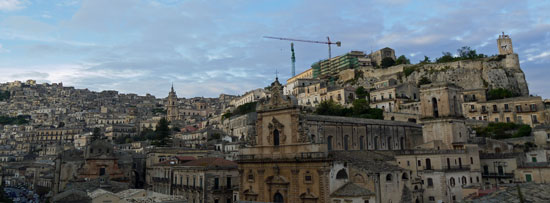About Modica
Modica is an attractive historic town in south-eastern Sicily, one of the area’s UNESCO-listed Baroque towns. Modica is particularly famous for its chocolate, and it is an appealing destination for food-lovers, making a good holiday base or day-trip destination.
- Sicily destinations and practicalities: full menu (at foot of this page)
Modica is situated in the dramatic landscape of the Monti Iblei, a range of high ground divided up by deep valleys and surprisingly populous towns. Important in Medieval times, Modica was rebuilt after the great earthquake of 1693 and now boasts fine late-Baroque architecture as well as a medieval old town.
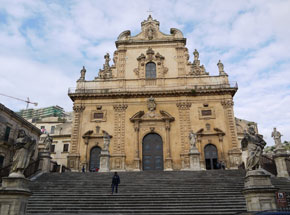
Modica is built around a junction of steep valleys, with the oldest part of town, Modica Alta (‘Upper Modica’) on a ridge in between. Modica Bassa (‘Lower Modica’) is the more recent (though still historic) district along the valley bottoms. Rivers once ran down Modica’s valleys, lined with buildings, but after a terrible flood in 1902, when they burst their banks, they were covered over. The town’s main street, Corso Umberto I, follows the course of one of these rivers, in the valley to the west of Modica Alta. Nowadays the busiest part of the town centre is at the junction of two valleys where Corso Umberto opens into Piazza Municipio, overlooked by an eighteenth-century hilltop clocktower.
Modica is a large and busy, authentically Sicilian town. It boasts some very fine Baroque architecture, picturesque views and historic lanes. It’s an interesting place to visit, though I found it slightly less charming than neighbouring Scicli and Ragusa. As well as Modica Alta and Modica Bassa, there is also a third part of town, Modica Sorda, a modern suburb detached from the historic part of Modica.
What to see in Modica
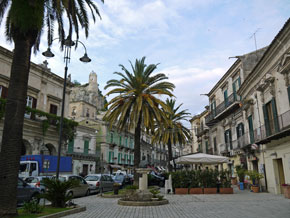
There is a helpful tourist information office on Corso Umberto, Modica’s valley-bottom high street, which is also the location for the town museum, its chocolate shops and a good proportion of its restaurants and cafes. This street, lined with worn, elegant buildings from the eighteenth and nineteenth centuries, is the place tourists are likely to spend the most time, and it’s a reference point for exploring the town.
This lower part of Modica – Modica Bassa – is busy, heavily-trafficked and thriving. Up steep slopes lies the upper town, the old medieval quarter, Modica Alta. Parts of the old town still retain the decrepit down-at-heel charm of a Sicilian village in years gone by; other parts are smartly renovated and restored. Narrow lanes, alleys and staircases climb up the slopes on both sides of Corso Umberto, towards the upper town and up the hillside opposite. Cars whizz perilously up and down these lanes, wing mirrors skimming the walls. I saw an old lady turning off Corso Umberto, stopping her car, taking a deep breath, reversing as if to take a run up, then zooming up an impossibly steep narrow lane.
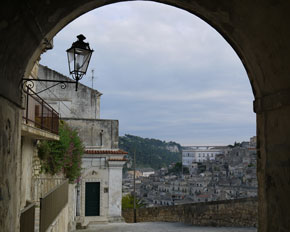
Modica has a remarkable number of impressive churches, including two grand Baroque cathedrals. Up a flight of steps from Corso Umberto, the Duomo di San Pietro was originally built in the fourteenth century, but destroyed by earthquakes in 1613 and again in 1693 before being rebuilt in the Baroque style in the eighteenth century. The church dominates this stretch of Corso Umberto, and its steps are ornamented with large statues of apostles and saints.
Higher up the slopes towards the old town perches the theatrical Duomo di San Giorgio, Modica Alta’s cathedral and the town’s most remarkable building. Like most of the area’s great architecture, it was created in the local Baroque style after the 1693 earthquake destroyed the previous building. The grand façade rises up into a curved central belltower. The twin staircases climbing to the church are attractive with little half-wild gardens swarming with roses, wisteria and palms. The church interior is decorated with gilding and pastel blue stucco, and contains a number of interesting sights including a statue of St. George carried around town in the saint’s festivities, a rich silver altarpiece and an old, worn marble stoup, also featuring St. George. Look out for the solar meridian line across the transept, with a small hole (‘gnomon’) high up to let in the required ray of sunlight. On the left of the church is the elegant Baroque Palazzo Polara. Up a few steps just to the right of the church is Caffè Duomo, a cafe with a couple of outside tables on a little terrace; a pretty spot.
Climbing upwards to the left of the church the tourist can explore a steep maze of village-type dwellings; some ruinous, some well kept, some for sale. At the top is the Belvedere Pizzo, a good viewpoint with benches and views over the Modica valleys. Along the street from here is another imposing church, the nineteenth-century Chiesa di San Giovanni, with another grand staircase and extravagant façade.
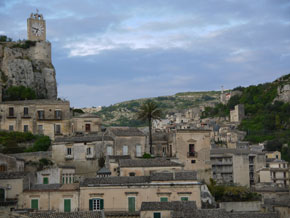
Corso Regina Margherita is a sloping street leading down from the heart of the upper town, lined with lovely old palaces, many of them crumbling, some inhabited with flower-bedecked balconies. This old town feels significantly less cosmopolitan and modern than the lower town, with old-fashioned shops, and elderly residents positioned at windows, doorways and gates to watch the world (such as there is in Modica Alta) go by. I visited at Easter and found not only the handsome Chiesa di Santa Teresa decked in palms from Palm Sunday but also the bus stop and road signs festooned. It’s not all like illustrations from history books, though; there are also a couple of classy restaurants and a good hotel at the upper end of town.
Modica’s historic castle complex dominates the end of the ridge overlooking the heart of the lower town – a site with a long history, archaeological remains, old prisons and passages leading down to the lower town, but closed for restoration and redevelopment (into a convention centre) at the time of writing.
There are various ways to descend into Modica Bassa. Walking down Via Castello by the castle, you can branch left to enter Modica’s eastern valley, where there are some intriguing cave dwellings built into the rockface (reminiscent of nearby Scicli). Look out for the church of Santa Maria di Bedlem, which has a pre-earthquake relief on its external side wall which still bears traces of paint. Inside the church is a fifteenth-century chapel.
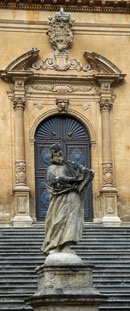
After the grand churches of Modica, visitors should seek out something very different: a historic cave church. The Chiesa Rupestre di San Nicolò Inferiore was “found by chance” in 1987, and contains Byzantine wall-paintings. There’s a small entrance fee. Check current opening hours on the notice outside or with the tourist information office; the church is closed Mondays and most afternoons.
Travellers with an interest in antiquities shouldn’t miss the town museum, the Museo Civico (on Corso Umberto; closed Mondays; small admission fee). Its collection originated with a local collector, and ranges from fossils to majolica ware. Displays include Greek and Roman ceramics, and grave goods from the Modica area including the archaeological site of Cava d’Ispica. The museum’s prize exhibit, which would be worth the admission fee on its own, is a bronze statuette of Hercules, 22cm high. Found in a river bed in 1967, the statue is Hellenic in style and probably dates to the 3rd century BC. Hercules stands poised, his weight on one leg, in a little masterpiece of dynamism and elegance.
The Chiesa del Carmine is a charming church just off the high street in the lower town. Damaged by the big seventeenth-century earthquakes, it nevertheless still retains its Gothic doorway and a rose window, beneath a later extension to the upper façade. The interior is rather sweet, decorated in white and gold, with red hangings, a statue of the Madonna breast-feeding (Madonna del Latte), old carved wooden confession booths and a late-Gothic chapel (follow signs) with some traces of fresco.
Once visitors have toured the sights listed above and visited a few of Modica’s gourmet destinations (more below), they’ll have seen the best of the town. If you have longer, though, there is still more to explore, including picturesque lanes, an unfinished church (Santuario della Madonna delle Grazie), a ruined chapel and stray blue-eyed cats. Visitors with an interest in Italian poetry may want to visit the birthplace of twentieth-century poet Salvatore Quasimodo, the Casa Quasimodo, near the castle. The house is open to the public as a museum.
The town hall (Municipio) is housed in a former Dominican monastary. Within the public courtyard area are the steps to a 16th-century frescoed crypt where important corpses were once mummified. Shamefully, given its location, this crypt was locked up and abandoned when we visited; hopefully future visitors will be more fortunate.
Fans of Sicilian TV detective Inspector Montalbano (Il Commissario Montalbano) will be happy to spot locations from the TV series around Modica, including a doorway and balcony below San Giorgio where he was sworn at by a foul-mouthed old woman. Read about Montalbano locations in Sicily.
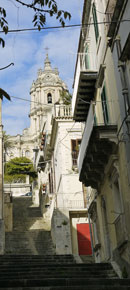
Events
I visited Modica at Easter and witnessed a solemn Via Crucis procession in the evening, with a statue of dead Jesus followed by one of Mary accompanied by readings, music, a child choir and a couple of hundred dark-clad followers. Modica also has a famous daytime Easter procession, the Madonna Vasa Vasa, in which an arm-waving statue of the Madonna meets the Risen Christ – I’d highly recommend looking this up on Youtube to get a taste of the colourful occasion. The feast-days of Saints George and Peter are also the occasion for processions.
Modica’s two greatest features are combined in a cunningly-named annual event called Chocobarocco which lasts for a few days in the autumn and includes a range of historical and chocolate-related events, activities and displays, from chocolate sculptures to chocolate massages.
Eating and drinking
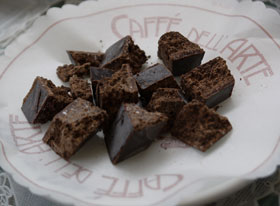
Modica chocolate is rich, dark and crumbly, produced in a traditional method imported from the New World by Sicily’s Spanish overlords. It can be melted, or eaten solid. The most famous chocolate-maker, often featured on TV, is the Antica Dolceria Bonajuto (Corso Umberto I, 159) but there are several other good manufacturers in town. We loved the Caffè dell’Arte (Corso Umberto I, 114), a family-run cafe which sells its own brand of chocolate in a large range of delicious flavours, from vanilla to agrumi (citrus fruits). The traditional flavours are vanilla and cinnamon, but you’ll find all kinds of flavours nowadays, including chili pepper and sea salt. There are free samples available in the town’s shops and it is easy to turn a tour of Modica into a gastronomic pilgrimage. One speciality you might want to try (but vegetarians beware) is the ‘mpanatigghie. This nearly-unpronouncable delicacy is a kind of minced-beef-and-chocolate sweet.
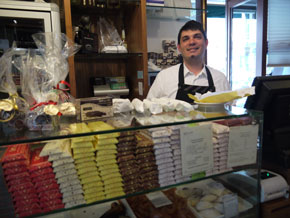
For savoury snacks, try the local scacce, a kind of focaccia with stuffings such as broccoli, aubergine and tomato.
There’s a good choice of restaurants in town, of varying quality and prices. Cheaper meals can be eaten at cafe tables and from takeaway shops selling scacce, arancini and other filling snacks. We ate at I Baccanti (Via Grimaldi), which had a small simple interior, and served simple pasta and meat dishes, including cavallo (horse). If you don’t mind something colourful but touristy, try the Osteria dei Sapori Perduti (Corso Umberto, 228). This is a friendly, busy restaurant featuring a menu in dialect, accompanied by a ‘book’ containing ingredient lists, photos, descriptions and wine recommendations in a variety of languages including Italian and English. A musician wandered around the restaurant for most of our meal, singing Italian traditional songs.
Around Modica
The other Baroque towns of the Val di Noto UNESCO heritage area are all in easy reach of Modica. They can be visited as excursions, or incorporated into a touring holiday; we stayed in Modica between nights in Scicli and Ragusa. You can read more about public transport below.
One of the most interesting places near Modica is the archaeological park of Cava d’Ispica. We took a taxi (organised by our B&B) to visit this fascinating spot. The peaceful green setting, with rock-cut cave tombs in a valley full of flowers and greenery, made a really pleasant contrast to the urban part of our holiday.
Travel to Modica
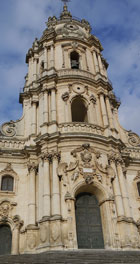
Urban buses run from Corso Umberto to Modica Alta, for those who don’t fancy the uphill climb.
An airport at Comiso, which may open in the near future, will be the nearest airport to Modica. In the meantime, the best way to reach the area is flying into Catania Airport, connected with Modica by AST bus. The journey takes just under two hours. AST also run services connecting Modica with other nearby towns including Ragusa, Noto, Scicli, Marina di Modica (Modica’s nearby seaside resort) and Siracusa.
Buses to and from Modica stop in a parking lot at the northern end of Corso Umberto. There is a gentle downhill walk into the town centre, which takes around fifteen minutes. Bus tickets can be bought from the Barycentro bar opposite the bus stops. Timetables can be viewed in the bar and on a display at the stops – when studying these, travellers should note that da Modica means FROM Modica and per modica means TO Modica.
Modica also has a railway station, to the west of the town centre. It’s on a railway line which runs from Siracusa through several Baroque towns including Noto and Scicli, before reaching Modica.
Modica accommodation
Where to stay in Modica depends upon your energy levels and means of transportation. There are good places to stay and eat in Modical Alta, but this is a steep walk or drive from the busy valley bottom streets. If you are relying on public transport, or looking for convenience, it is probably more practical to stay in the lower part of town. We stayed in a very convenient guest house just off the main street, with a lovely little roof terrace: Le Magnolie
> Le Magnolie.
Other options include:
- Candelieri19 – lovely-looking B&B in a renovated building with exposed stone walls for historic appeal
- The four-star Hotel Failla, perhaps the best hotel in town, uphill from the modern centre
- Hotel Torre del Sud – modern hotel in modern part of town 3km from the historic centre, with a car park
- Il Giardino dei Mandarini – upper-town B&B with a little garden
- La Casa dello Zodiaco, apartments in a historic building.
- Hotel Ferro, out of the centre, near the railway ststion, with a car park
> Availability search for accommodation in Modica
Highlights
Montalbano locations (blog article)
Useful external links
